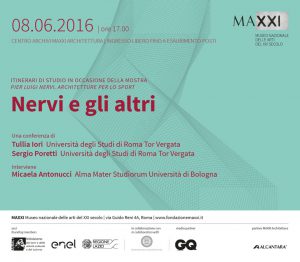 Mercoledì 8 giugno, alle 17:00, al MAXXI, nel Centro Archivi di Architettura, i professori Tullia Iori e Sergio Poretti del DICII – Dipartimento di Ingegneria Civile e Ingegneria Informatica tengono una conferenza a due voci dal titolo:
Mercoledì 8 giugno, alle 17:00, al MAXXI, nel Centro Archivi di Architettura, i professori Tullia Iori e Sergio Poretti del DICII – Dipartimento di Ingegneria Civile e Ingegneria Informatica tengono una conferenza a due voci dal titolo:
“Nervi e gli altri”
L’incontro è dedicato alla lettura di quattro linguaggi strutturali, tra i più significativi, della Scuola Italiana di Ingegneria.
Si parte da Pier Luigi Nervi, negli anni del miracolo economico e del boom dell’ingegneria italiana, per cogliere l’unicità delle sue “forme naturalmente resistenti”, così diverse dalle coeve “figure artificialmente in equilibrio” di Riccardo Morandi. Il racconto prosegue con le “essenziali strutture di design” di Silvano Zorzi che magistralmente prolungano la vita della Scuola italiana negli anni Settanta, per arrivare alle “visionarie forme senza nome” di Sergio Musmeci, che completano il quadro dell’identità delle strutture Made in Italy.
La conferenza tocca temi della ricerca SIXXI.
L’ingresso è libero.
